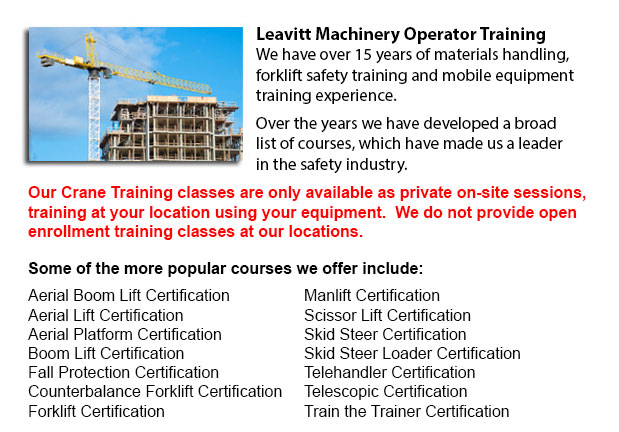
Hamilton Crane Certification - The Crane Certification Program consists of the industry recommended subject matter that will teach the safe and efficient operation of cranes. The individual would train in the following: how to identify cranes and their component parts; pre-operational, operational and post-operating requirements; how to determine overall lift capacity; rigging components and inspection/rejection criteria; and requirements particular to the work place where the people training would be operating.
The requirements that have to be done prior to operating a crane like for instance assigning authority for the pre-operational check; doing the sequential pre-operational check based on the manufacturer's specifications or specifications certified by a professional engineer; inspecting the work area for hazards and obstacles; checking the log book for comments; inspecting cables, hooks, chains safety latches and crane movement; ensuring the right functioning of operational controls; and knowing how to make certain that the crane's disconnect switch/isolator is functioning right.
Operational requirements comprise identifying responsibilities and roles, and determining the requirement for a formal lift plan. Trainees would learn how to carry out a danger assessment associated to environmental situations, physical situations and staff. Subject matter includes determining when to seek competent aid, the safest route and destination of loads, and load weight and centre of gravity.
It is vital for trainees to be able to identify an over-capacity lift, choose proper rigging machine, know load restrictions, and determine a safe position from which to work. Trainees will review both site-specific and universal crane signals for lifts, and techniques for lifting, loading and traveling. Correct maintenance habits would be included.
The trainee will undergo an examination to test their knowledge of emergency response techniques for various situations, particularly mechanical or electrical failures. They will be asked to describe shut down and parking procedures for security and safety, to follow lock out and tagging techniques, and to explain the reason why near misses are reported and recorded to the right person. Log book records need to be maintained.
The individual training will know the particulars of rigging, and learn the authority and responsibility for rigging. They will know to identify the different types of rigging, the load capacity ratings and storage procedures.
Post-operational requirements include entering defects or deficiencies, service and maintenance history in the log book, according to provincial, federal and state codes requirements.
Site-specific requirements could be incorporated into the safety training program according to the employer's needs.
-
Hamilton Aerial Platform Training
Hamilton Aerial Platform Training - Aerial hoists are able to accommodate various odd jobs involving high and hard reaching spaces. Often utilized to perform routine repair in structures with high ceilings, prune tree branches, hoist heavy shelving u... More -
Hamilton Heavy Equipment Operator Certification
Hamilton Heavy Equipment Operator Certification - The heavy equipment operator is a person who manipulates the controls and drives different kinds of big machinery. Heavy machinery is most commonly utilized on construction sites to deliver supplies t... More -
Hamilton Scissor Lift Ticket
Hamilton Scissor Lift Ticket - Scissor lifts have greatly benefited construction operations in view of the fact that the job that used to require much effort and lots of people, can now be completed utilizing the scissor lift truck and only one indiv... More -
Hamilton Forklift Certification Courses
Hamilton Forklift Certification Courses - Forklift certification courses really help to make sure that businesses utilizing forklifts, comply with the regional and local rules. The drivers of the forklift should undergo forklift certification prior t... More -
Hamilton Forklift Training Program
Hamilton Forklift Training Program - The forklift is a common powered industrial vehicle which is in wide use these days. They are occasionally called jitneys, hi los or lift trucks. A departments store would use the forklift to unload and load merch... More -
Hamilton Forklift License
Hamilton Forklift License - Obtaining a forklift license or forklift certification in North America would require the trainee to do hands-on training in addition to classroom instruction. The state, provincial and federal regulatory bodies are respon... More -
Hamilton Manlift Operator Certification
Hamilton Manlift Operator Certification - Our aerial lift and scissor platform training and certification empowers participants with a general understanding and knowledge of the efficient and safe use of "Power Operated Mobile Work Platforms," under... More -
Hamilton Forklift Operator Certification
Hamilton Forklift Operator Certification - Forklift operator certification is usually needed for employees working in industrial, warehouse or construction setting to guarantee the safe utilization of forklifts. Workplace training has to follow a met... More

Forklift Certification Hamilton
TOLL FREE: 1-888-254-6157
Hamilton, Ontario
forkliftcertificationhamilton.com
Email Us
About Us


